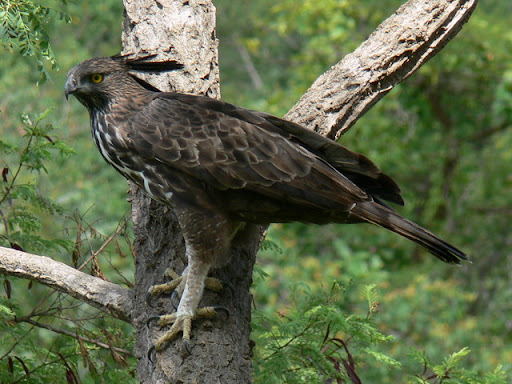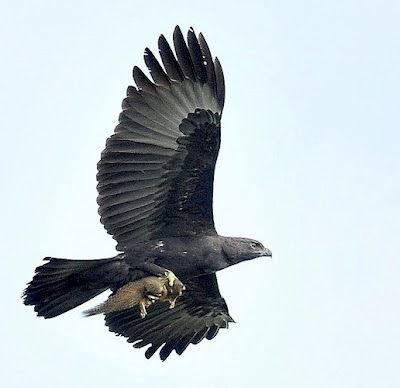Post by OldGreenVulture on Sept 27, 2019 12:18:53 GMT
Changeable (Crested) Hawk-eagle - Nisaetus cirrhatus.

Scientific classification
Kingdom: Animalia
Phylum: Chordata
Class: Aves
Order: Accipitriformes
Family: Accipitridae
Genus: Nisaetus
Species: Nisaetus cirrhatus
Biometrics:
Size : 59 - 77 cm
Wingspan : 114-150 cm
Weight : 1.3-1.9 kg (2.86-4.18 lb)
www.oiseaux.net/birds/changeable.hawk-eagle.html

The Crested Hawk-eagle or Changeable Hawk-eagle (Nisaetus cirrhatus), is a bird of prey of the family Accipitridae. They were formerly placed in the genus Spizaetus but studies pointed to the group being paraphyletic resulting in the Old World members being placed in Nisaetus (Hodgson, 1836) and separated from the New World species.
The Changeable Hawk Eagle (Spizaetus cirrhatus) found in this part of the world is the subspecies limnaeetus. It is crestless and is found from the Himalayan foothills down through Southeast Asia into Greater Sundas to Philippines. This subspecies is polymorphic, with a dark and a pale morph (below).
Description
The Crested hawk-eagle is a medium-large raptor at about 60–77 cm in length. It is a relatively slender forest eagle with some subspecies (especially limnaetus) being dimorphic giving the name of "Changeable".
This, and also a complicated phylogeny further complicates precise identification.
Normally brown above; white below with barring on the undersides of the flight feathers and tail; black longitudinal streaks on throat and chocolate streaks on breast. 'Some subspecies have a crest of four feathers, but this is all but absent in others' Sexes alike; female larger, and young birds are often whiter-headed and less patterned.
The wings are long and parallel-sided, and are held flat in flight, which helps to distinguish this species from the similar Mountain Hawk Eagle. In overhead flight, comparatively rounded wings (upturned at tip), longish tail, white body (spotted with brown) and grey underside of wings (streaked and spotted) are leading pointers.
Call: A loud, high-pitched ki-ki-ki-ki-ki-ki-ki-ki-kee, beginning short, rising in crescendo and ending in a scream.
A Juvenile
The sexes are similar but the female is slightly larger. The juvenile (pale morph) is distinct, with its head and underparts largely white (left). Juveniles begin to breed in the third year and become fully adult in fourth year or later. The adult pale morph is brown above, with pale edges, especially on wing coverts. The pale brown tail has a thin whitish tip, broad blackish subterminal band and three to four other narrower, browner and often much more obscure bars. The white to buff area of the throat to breast and upper belly and flanks are more or less boldly streaked with black to dark brown.
The adult dark morph is entirely blackish-brown, including the uppertail, the inner half being greyer.
The wings are shortish, with the wing tips about one-third to half down tail; tail long and thinly-banded. Legs are long, feathered; appearing spindly because of the short tibial feathering.
The bird perches upright, especially in the early morning and afternoon. It stays for long periods waiting patiently for prey. These may include squirrels, birds, snakes and lizards.
During mornings, the eagle soars alone or in pairs, taking advantage of the thermals.

Ecology
Changeable Hawk Eagles eat mammals, birds and reptiles. They like to keep a sharp lookout perched bolt upright on a bough amongst the canopy foliage of some high tree standing near a forest clearing (see photos). There they wait for junglefowl, pheasants, hares and other small animals coming out into the open. The bird then swoops down forcefully, strikes, and bears the prey away in its talons.
From Carnivora.
carnivora.net/changeable-crested-hawk-eagle-nisaetus-cirrhatus-t2336.html#p4901

Scientific classification
Kingdom: Animalia
Phylum: Chordata
Class: Aves
Order: Accipitriformes
Family: Accipitridae
Genus: Nisaetus
Species: Nisaetus cirrhatus
Biometrics:
Size : 59 - 77 cm
Wingspan : 114-150 cm
Weight : 1.3-1.9 kg (2.86-4.18 lb)
www.oiseaux.net/birds/changeable.hawk-eagle.html

The Crested Hawk-eagle or Changeable Hawk-eagle (Nisaetus cirrhatus), is a bird of prey of the family Accipitridae. They were formerly placed in the genus Spizaetus but studies pointed to the group being paraphyletic resulting in the Old World members being placed in Nisaetus (Hodgson, 1836) and separated from the New World species.
The Changeable Hawk Eagle (Spizaetus cirrhatus) found in this part of the world is the subspecies limnaeetus. It is crestless and is found from the Himalayan foothills down through Southeast Asia into Greater Sundas to Philippines. This subspecies is polymorphic, with a dark and a pale morph (below).
Description
The Crested hawk-eagle is a medium-large raptor at about 60–77 cm in length. It is a relatively slender forest eagle with some subspecies (especially limnaetus) being dimorphic giving the name of "Changeable".
This, and also a complicated phylogeny further complicates precise identification.
Normally brown above; white below with barring on the undersides of the flight feathers and tail; black longitudinal streaks on throat and chocolate streaks on breast. 'Some subspecies have a crest of four feathers, but this is all but absent in others' Sexes alike; female larger, and young birds are often whiter-headed and less patterned.
The wings are long and parallel-sided, and are held flat in flight, which helps to distinguish this species from the similar Mountain Hawk Eagle. In overhead flight, comparatively rounded wings (upturned at tip), longish tail, white body (spotted with brown) and grey underside of wings (streaked and spotted) are leading pointers.
Call: A loud, high-pitched ki-ki-ki-ki-ki-ki-ki-ki-kee, beginning short, rising in crescendo and ending in a scream.
A Juvenile
The sexes are similar but the female is slightly larger. The juvenile (pale morph) is distinct, with its head and underparts largely white (left). Juveniles begin to breed in the third year and become fully adult in fourth year or later. The adult pale morph is brown above, with pale edges, especially on wing coverts. The pale brown tail has a thin whitish tip, broad blackish subterminal band and three to four other narrower, browner and often much more obscure bars. The white to buff area of the throat to breast and upper belly and flanks are more or less boldly streaked with black to dark brown.
The adult dark morph is entirely blackish-brown, including the uppertail, the inner half being greyer.
The wings are shortish, with the wing tips about one-third to half down tail; tail long and thinly-banded. Legs are long, feathered; appearing spindly because of the short tibial feathering.
The bird perches upright, especially in the early morning and afternoon. It stays for long periods waiting patiently for prey. These may include squirrels, birds, snakes and lizards.
During mornings, the eagle soars alone or in pairs, taking advantage of the thermals.

Ecology
Changeable Hawk Eagles eat mammals, birds and reptiles. They like to keep a sharp lookout perched bolt upright on a bough amongst the canopy foliage of some high tree standing near a forest clearing (see photos). There they wait for junglefowl, pheasants, hares and other small animals coming out into the open. The bird then swoops down forcefully, strikes, and bears the prey away in its talons.
From Carnivora.
carnivora.net/changeable-crested-hawk-eagle-nisaetus-cirrhatus-t2336.html#p4901

